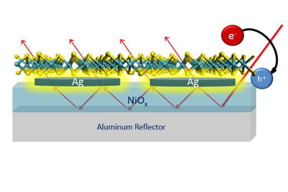Molybdenum disulfide holds promise for light absorption: Rice researchers probe light-capturing properties of atomically thin MoS2
"Basically, we want to understand how much light can be confined in an atomically thin semiconductor monolayer of MoS2," said Thomann, assistant professor of electrical and computer engineering and of materials science and nanoengineering and of chemistry. "By using simple strategies, we were able to absorb 35 to 37 percent of the incident light in the 400- to 700-nanometer wavelength range, in a layer that is only 0.7 nanometers thick."

Using a layer of molybdenum disulfide less than one nanometer thick, researchers in Rice University's Thomann lab were able to design a system that absorbed more than 35 percent of incident light in the 400- to 700-nanometer wavelength range.
Thomann and Rice graduate students Shah Mohammad Bahauddin and Hossein Robatjazi have recounted their findings in a paper titled "Broadband Absorption Engineering To Enhance Light Absorption in Monolayer MoS2," which was recently published in the American Chemical Society journal ACS Photonics. The research has many applications, including development of efficient and inexpensive photovoltaic solar panels.
"Squeezing light into these extremely thin layers and extracting the generated charge carriers is an important problem in the field of two-dimensional materials," she said. "That's because monolayers of 2-D materials have different electronic and catalytic properties from their bulk or multilayer counterparts."
Thomann and her team used a combination of numerical simulations, analytical models and experimental optical characterizations. Using three-dimensional electromagnetic simulations, they found that light absorption was enhanced 5.9 times compared with using MoS2 on a sapphire substrate.
"If light absorption in these materials was perfect, we’d be able to create all sorts of energy-efficient optoelectronic and photocatalytic devices. That’s the problem we’re trying to solve," Thomann said.
She is pleased with her lab's progress but concedes that much work remains to be done. "The goal, of course, is 100 percent absorption, and we're not there yet."
Source: Nanotechnology Now
- 299 reads
Human Rights
Ringing FOWPAL’s Peace Bell for the World:Nobel Peace Prize Laureates’ Visions and Actions

Protecting the World’s Cultural Diversity for a Sustainable Future

The Peace Bell Resonates at the 27th Eurasian Economic Summit

Declaration of World Day of the Power of Hope Endorsed by People in 158 Nations

Puppet Show I International Friendship Day 2020

